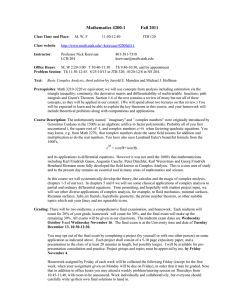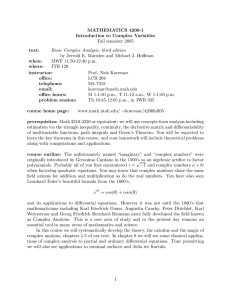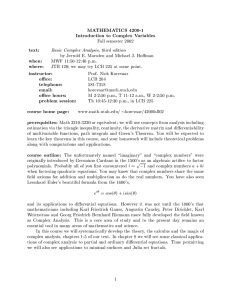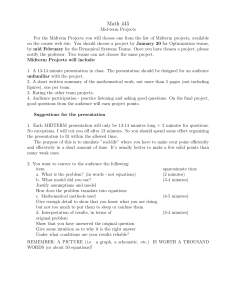Mathematics 4200-1 Fall 2007
advertisement
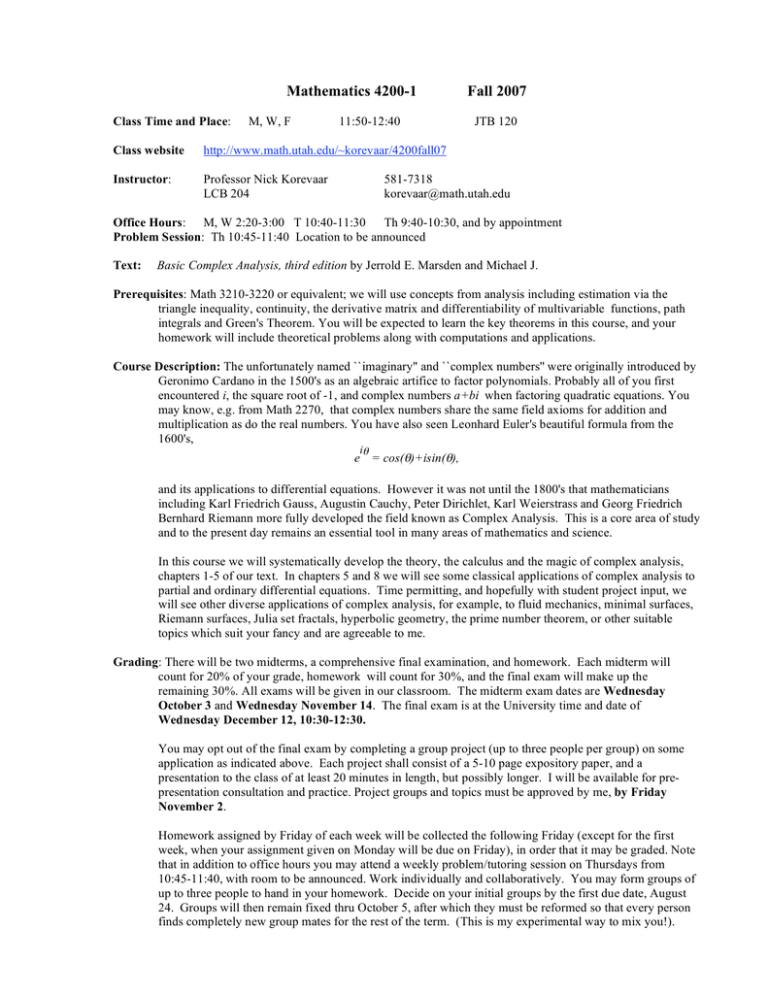
Mathematics 4200-1 Class Time and Place: M, W, F 11:50-12:40 Class website http://www.math.utah.edu/~korevaar/4200fall07 Instructor: Professor Nick Korevaar LCB 204 Fall 2007 JTB 120 581-7318 korevaar@math.utah.edu Office Hours: M, W 2:20-3:00 T 10:40-11:30 Th 9:40-10:30, and by appointment Problem Session: Th 10:45-11:40 Location to be announced Text: Basic Complex Analysis, third edition by Jerrold E. Marsden and Michael J. Prerequisites: Math 3210-3220 or equivalent; we will use concepts from analysis including estimation via the triangle inequality, continuity, the derivative matrix and differentiability of multivariable functions, path integrals and Green's Theorem. You will be expected to learn the key theorems in this course, and your homework will include theoretical problems along with computations and applications. Course Description: The unfortunately named ``imaginary'' and ``complex numbers'' were originally introduced by Geronimo Cardano in the 1500's as an algebraic artifice to factor polynomials. Probably all of you first encountered i, the square root of -1, and complex numbers a+bi when factoring quadratic equations. You may know, e.g. from Math 2270, that complex numbers share the same field axioms for addition and multiplication as do the real numbers. You have also seen Leonhard Euler's beautiful formula from the 1600's, iθ e = cos(θ)+isin(θ), and its applications to differential equations. However it was not until the 1800's that mathematicians including Karl Friedrich Gauss, Augustin Cauchy, Peter Dirichlet, Karl Weierstrass and Georg Friedrich Bernhard Riemann more fully developed the field known as Complex Analysis. This is a core area of study and to the present day remains an essential tool in many areas of mathematics and science. In this course we will systematically develop the theory, the calculus and the magic of complex analysis, chapters 1-5 of our text. In chapters 5 and 8 we will see some classical applications of complex analysis to partial and ordinary differential equations. Time permitting, and hopefully with student project input, we will see other diverse applications of complex analysis, for example, to fluid mechanics, minimal surfaces, Riemann surfaces, Julia set fractals, hyperbolic geometry, the prime number theorem, or other suitable topics which suit your fancy and are agreeable to me. Grading: There will be two midterms, a comprehensive final examination, and homework. Each midterm will count for 20% of your grade, homework will count for 30%, and the final exam will make up the remaining 30%. All exams will be given in our classroom. The midterm exam dates are Wednesday October 3 and Wednesday November 14. The final exam is at the University time and date of Wednesday December 12, 10:30-12:30. You may opt out of the final exam by completing a group project (up to three people per group) on some application as indicated above. Each project shall consist of a 5-10 page expository paper, and a presentation to the class of at least 20 minutes in length, but possibly longer. I will be available for prepresentation consultation and practice. Project groups and topics must be approved by me, by Friday November 2. Homework assigned by Friday of each week will be collected the following Friday (except for the first week, when your assignment given on Monday will be due on Friday), in order that it may be graded. Note that in addition to office hours you may attend a weekly problem/tutoring session on Thursdays from 10:45-11:40, with room to be announced. Work individually and collaboratively. You may form groups of up to three people to hand in your homework. Decide on your initial groups by the first due date, August 24. Groups will then remain fixed thru October 5, after which they must be reformed so that every person finds completely new group mates for the rest of the term. (This is my experimental way to mix you!).
